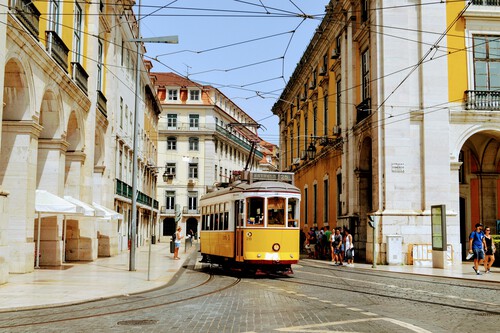Lisbon is known for its traditional pastéis de nata, fado music, sardines, and beautiful tiles. However, when it comes to the real estate market, the city is undergoing significant changes. Today’s Lisbon bears little resemblance to how it was two decades ago, before the financial crisis. The Portuguese capital has emerged on the international investment map and established itself as a popular tourist destination.
Unfortunately, this transformation has come at a cost. It’s now considered the least affordable city in Europe, with a real estate market that caters more to expats and tourists than to local residents.
Many foreign buyers purchase properties as second homes or for lucrative investments, while many locals find housing increasingly out of reach. As a result, many have abandoned the hope of renting entire apartments and are settling for renting just rooms instead.
An unaffordable city. Lisbon’s real estate market is dynamic, attractive to investors, and continues to rise in value. It’s also marked by a significant issue: unaffordability. According to Numbeo, Lisbon has the worst ratio of average housing prices to family income. This disparity is particularly evident from the perspective of locals looking to buy homes.
Numbeo assigns Lisbon a ratio of 21.1, which is higher than several other large and expensive European cities. This includes London (18.6), Paris (16.9), Munich (15), Vienna (14.9), and Barcelona (12.5).

Prices and income. The housing market in Lisbon isn’t necessarily more expensive than in other cities, but the country has remarkably low income levels. Despite gradual increases, the minimum wage remains low, and the average gross monthly salary in 2024 was around $1,800. “In a country where 60% of taxpayers earn less than [$1,170] a month, finding a rental below that price in the Portuguese capital is only possible if you’re willing to live in [215 square feet]–or less,” Agustín Cocola-Gant, a researcher at the University of Lisbon, highlights in an article for The Guardian.
176%. Data from Numbeo reflects the significant changes that Lisbon’s real estate market has undergone over the past decade. Some calculations indicate that housing prices have increased by 176% from 2014 to 2024, with even higher increases observed in the historic center. According to property search portal Idealista, the price per square foot in the sales market was $240 in 2015, whereas today it reaches $620. For rentals, the price has risen from $0.90 per square foot to $2.40 per square foot during the same period.
Forecasts for the sector indicate that these values are expected to continue rising. Real estate services company Savills predicts that housing prices in both Lisbon and Porto will keep rising in 2025, driven by an ongoing recovery following earlier market corrections. The market remains stable, with steady growth contributing to a positive outlook for the coming year. While Lisbon’s situation is particularly noteworthy, the trend of increasing prices is spreading throughout Portugal.
Looking back. Why has Lisbon become so expensive? How has it transformed into the least affordable city in Europe in terms of housing prices? According to Cocola-Grant, the key lies in the years following the 2008 financial crisis, when Portugal implemented an emergency plan. Among other objectives, the plan aimed to make Lisbon a more attractive destination for tourism and real estate investment.
Cocola-Grant points out that the approach to achieving this wasn’t novel. The government made the rental market more flexible and used fiscal policies to attract investment funds. It also offered incentives to draw buyers who didn’t reside in Portugal. In 2012, the country introduced its Golden Visa program, resulting in the accumulation of billions of dollars in investment.
Tourists, nomads, and expats. Notably, the country aimed to attract not only real estate investment. It also wanted to establish itself as a destination for digital nomads, students, travelers, and tourists seeking both hotel accommodations and temporary apartment rentals. As a result, thousands of homes in the city began appearing on Airbnb, displacing traditional tenants and adding further pressure to the housing market.
According to Portuguese digital publication Mensagem de Lisboa, between 2014 and 2018 alone, short-term rentals grew at an annual rate of 100% in Lisbon, particularly in areas in the historic center such as Misericórdia and Santa Maria Maior.
“Dramatic levels.” According to Cocola-Grant, rentals listed on platforms like Airbnb have reached “dramatic levels” in the historic center of Lisbon. Around 70% of homes in the most touristy neighborhoods hold a short-term rental license. This density surpasses that of other heavily touristed cities such as London and Barcelona. Moreover, the hotel supply has skyrocketed, tripling since 2010, with numerous new projects on the horizon.
Gentrification. Cocola-Grant explains that low interest rates and tax advantages attracted investors to Lisbon’s real estate market. The favorable conditions allowed for property appreciation, making homes highly sought after in the rental market. While this investment facilitated property renovations, it also contributed to gentrification, a phenomenon previously uncommon in much of the city.
“Despite the improvements, the centre of the city lost 25% of its population between 2011 and 2021,” Cocola-Grant says. His calculations reveal that only 56.5% of the homes built or renovated during that period became primary residences. Essentially, much of the renovation work resulted in homes that are now empty, used for temporary rentals, or maintained as second homes.
Lisbon for its residents? “The result is a city that welcomes foreign wealth but excludes many of its own citizens, prioritising the desires of global consumers over the needs of local communities,” Cocola-Grant adds. A quick search through the Internet shows that not all Lisbon residents welcome this rapid transformation.
In recent years, there have been citizen campaigns aimed at reducing vacation rentals, signs of discontent regarding the influx of digital nomads, and protests calling for greater access to housing. Residents have even expressed frustration that Lisbon’s iconic yellow trams, once a vital service for locals, have become more of a “toy” for tourists than a means of transport for the city’s inhabitants.
Images | Aayush Gupta | Jorge Franganillo




View 0 comments